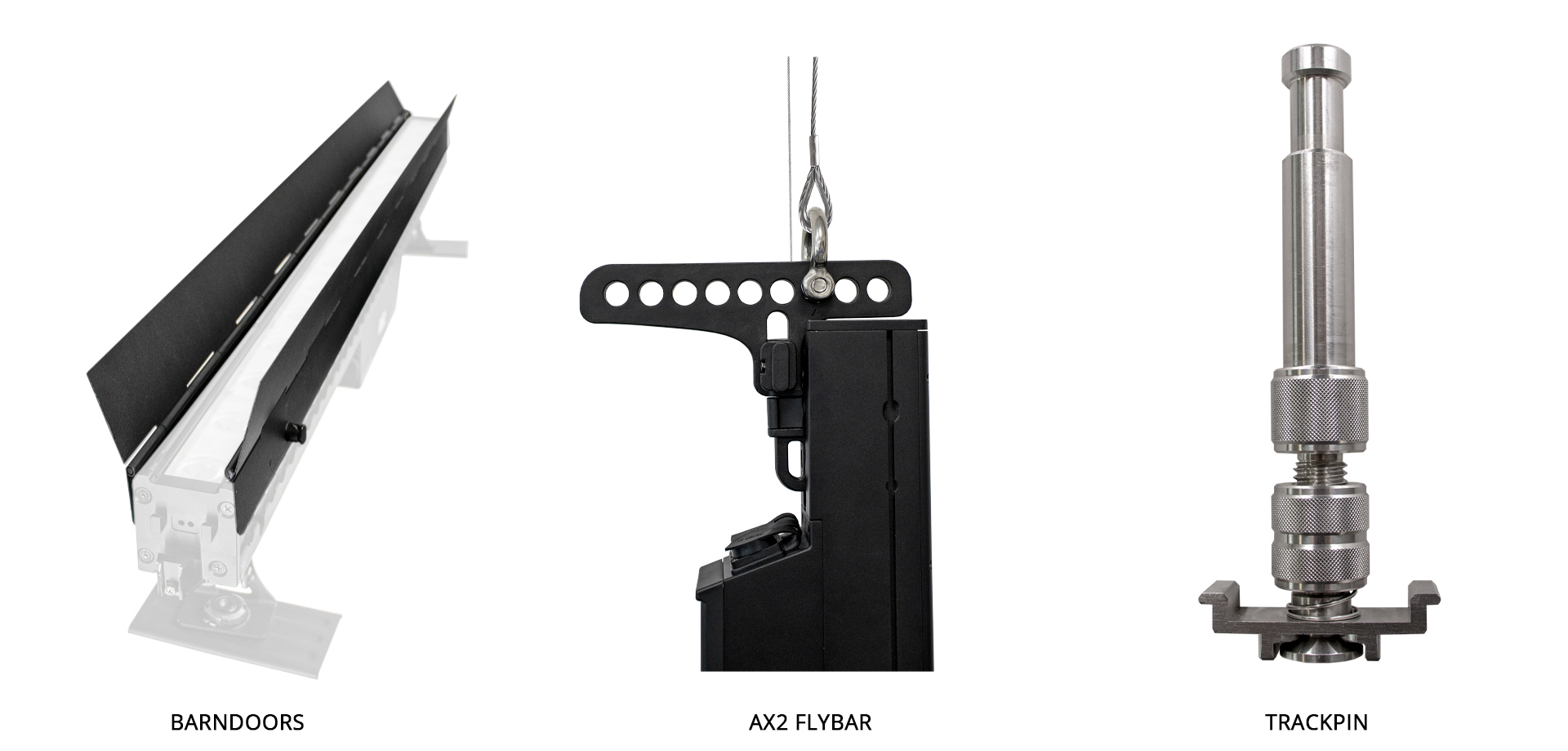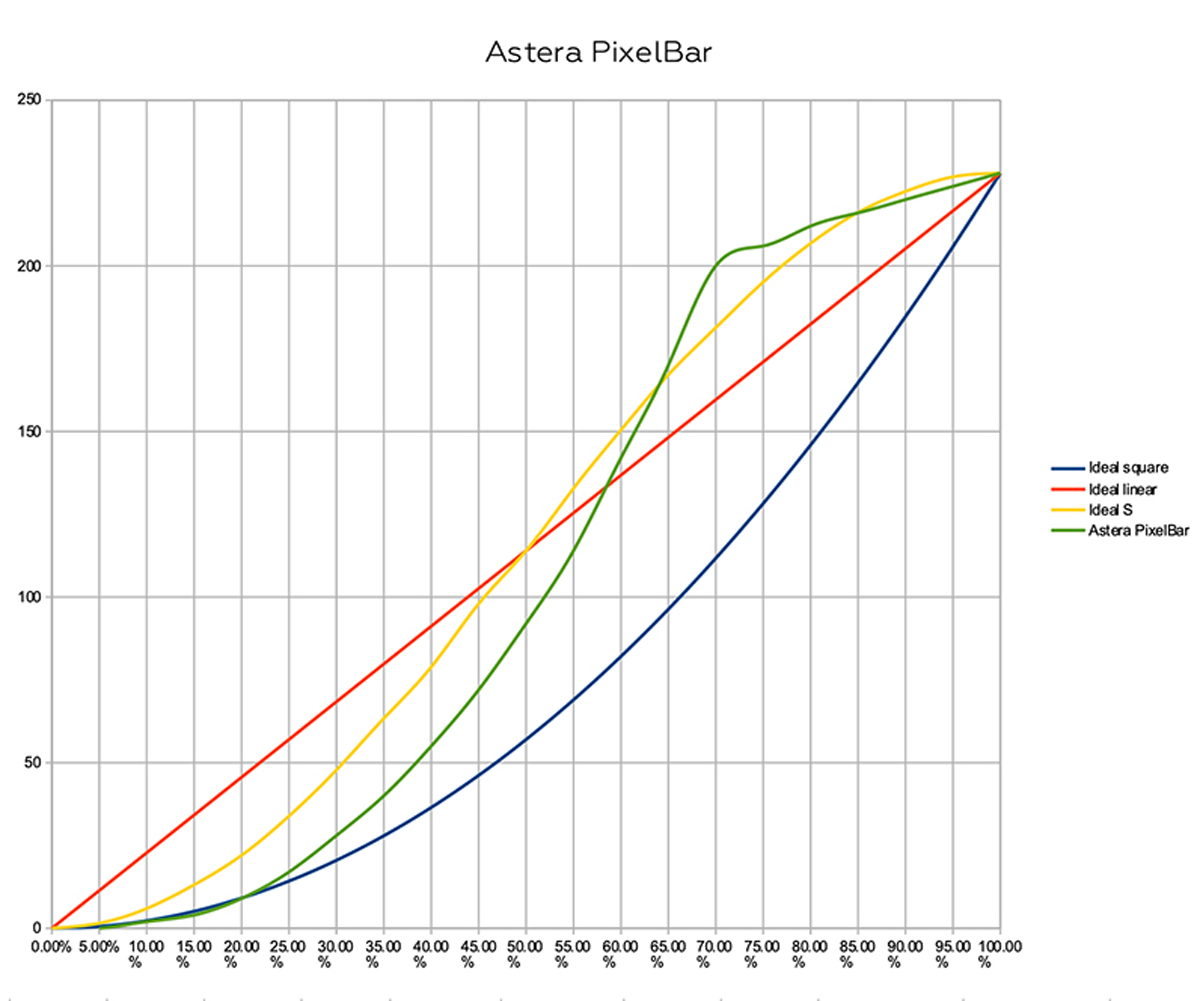Astera AX2 PixelBar 100
August 2021, by Craig Rutherford – published at PLSN
Battery-powered lights are fabulously useful things. Particularly in the realm of corporate and events lighting, it’s common for the lighting crew to run into situations where cabling is either difficult to run or is objectionable for aesthetic reasons. Battery-powered luminaires can easily be deployed shortly before the show and easy to strike at the end of the night, and adding splashes of light and color to an otherwise drab space is our raison d’être. But battery-powered lights present a drawback — a glaring one, if you will: the battery itself. Key to their portability but attaching inherent restrictions, batteries add weight and have inescapable run time limitations. There are many strategies to help manage this, and few companies have been quite as successful at it than Astera, founded in the mid-2000s in Germany. Today, we’re looking at one of their latest offerings: a solidly-built pixel-mappable LED batten, with a plethora of features aimed solidly at the film, broadcast, and events industry.
Battery-powered lights are fabulously useful things. Particularly in the realm of corporate and events lighting.
Fixture Features
The fixture utilizes RGBMA (Mint and amber) packages topped with TIR lenses to manage the native distribution of the light down to a more useful 21-degree zoom. Pitch between adjacent pixels is 2.4 inches, and the two battens in the family (The AX2-100 and AX2-50) come in meter (16 pixels) and half-meter (eight pixels) lengths, respectively, and total power for the LED packages is rated at 160W and 80W. Runtime on battery will, of course, vary greatly depending on what the fixtures are doing, how many diodes are running and at what intensity, but Astera rates these fixtures to run up to 20 hours in most cases. Key to the usability of these lights is the ability to select a runtime (between two and 20 hours), and the fixture will dynamically dim the LEDs over the course of the runtime based on available battery power. Shorter runtimes will permit brighter LEDs. Conversely, by selecting longer runtimes, the fixture will run them at lower levels to preserve power.
The addition of the Mint emitter helps tremendously with mixing white tones of various color temperatures, while the amber emitter fills in the red / orange / yellow gaps that can be very noticeable, particularly in RGBW systems. Astera’s published TLCI values are upwards of 97 for the three most-used white settings (3200K, 4000K and 5500K).
Choice of measurement systems aside, to my eye, the whites are very clean and pleasing, with the warm whites in particular lacking the characteristic “fake” look that was a dead giveaway in early (and ongoing!) attempts to mimic low color temperatures with LEDs.
The fixture’s dimmer curve has a slight bump at the top end of the range (see related graphic, this page), but otherwise reasonably follows an ideal square law. Different dimmer curves are available in the menu. There was zero thermal droop, which Astera tells us is due to constant temperature and wattage monitoring of each individual pixel, with minute adjustments being done constantly to keep color and brightness perfectly consistent (within the bounds of the runtime setting, for times when the fixtures are on battery power.) For the AX2-100, I measured 445 lux at five meters with the fixture on wall power and the light setting at 5600K. These are linear battens intended primarily for wall-washing applications, so these figures do not represent the fixture’s brightness in the way it would be for, say, a hard-edged spot optical system. To my eye, they’re certainly bright enough to keep up with similar fixtures. The color mixing is smooth and even, with no multicolored shadows or hotspots. The fixtures feature adjustable PWM frequencies to help with flicker, adjustable via the AsteraApp.
Key to the usability of these lights is the ability to select a runtime (between two and 20 hours), and the fixture will dynamically dim the LEDs over the course
of the runtime based on available battery power.
Control Options and Accessories
There are a variety of ways to control this light, either through straight DMX, CRMX (LumenRadio) wireless DMX, or app control via Bluetooth to an AsteraBox (not included). Astera includes a variety of control modes, including addressing the pixels as a single block, differently-sized blocks, or single pixels. The fixture includes individual or “all pixels” strobes, adjusting the CCT, and controls for plus or minus green/magenta. To be brief, there’s a workable control scheme for most scenarios. The iOS or Android-based AsteraApp makes it easy to set up colors, programs, and effects and also includes several options for how the lights should respond in the event of data loss. A separate option lets the user set the lights to turn on to bright white in the event of AC power loss to act as emergency lighting.
Additional features include scheduled stand-by and wake-ups, and a BPM analyzer for solo musical acts to sync the lights with their beat. A variety of strobe functions are included, up to 25 Hz.
Beyond the thought that went into the LED emitters and lenses themselves, Astera has a host of accessories and features that advance the state of battens as a class by making deployment and control much easier than previous lights of this sort.
Starting with the simple things, the feet (for ground-supported applications) are high-quality and intelligently-designed, featuring a quick-release mechanism. There’s a large thumbscrew for adjusting the feet side-to-side, and the tracks in which the feet slide are of an “airline track” style to prevent the assembly from sliding around, once tightened. We note that there is a track on both the rear and the bottom of the light for flexibility. For connecting multiple battens together, there are not only built-in alignment guides, but the ends of each fixture also include an IR transmitter and receiver. These allow adjacent fixtures to communicate directly, removing the need for data cabling between them and allowing a line of fixtures to automatically address themselves sequentially via the AsteraApp.
For live events where the fixtures might be physically accessible to the audience or event-goers, the fixtures include a motion sensor that sound an audible alarm and flash the lights if the fixtures are moved. For spill control, there’s attachable barndoors available to direct the output of the light. Finally, there are additional options for flying the fixtures, either with hangars, fly bars, or pins (Babypins) that fit into the track for mounting to hardware like Manfrotto-style stands. Both fixtures also sport an IP65 rating for use on outdoor events, with rubberized power inputs and pass-throughs.
At-a-Glance:
Raising the Bar
The Astera PixelBar series raises the standard for portable linear battens. Built to withstand whatever is thrown at them, they also feature an array of accessories and features sure to delight anybody who needs high-quality portable lighting. These fixtures certainly rise to the level of film and theater-quality hardware, with a quality of light to match — in white light, colored, and everything in between.
AX2 PixelBar 100
PROS: Built to take a beating, long runtime, available in two sizes that can auto connect wirelessly w/ BarConnect+
CONS: None
FEATURES
• Linear wash fixture with built-in battery pack
• LEDs can be individually controlled
• RGBMA color mixing (Red, Green, Blue, Mint, Amber)
• TLCI (3200k-6500k): ≥96
• CRI (3200k-6500k): ≥96
• Strobe: 0-25Hz
• Backside Display with HSI control
• Wireless Control Range: 300m
• Aluminum Housing
• Easy to rig with smart stands, hanging bracket, connectable endcaps and the integrated airline track
SPECS
• Light source: 16 10W LEDs
• Maximum power draw: 160W
• Color mixing: RGBMA
• Max battery runtime: 20 hours
• Charging time: 5 hours
• Beam spread: 21°
• IP Rating: IP65
• Size: 1000 x 165 x 65cm/39.4 x 6.5 x 2.6”
• Weight:16.3 lbs.
• Control: DMX or wireless signal






